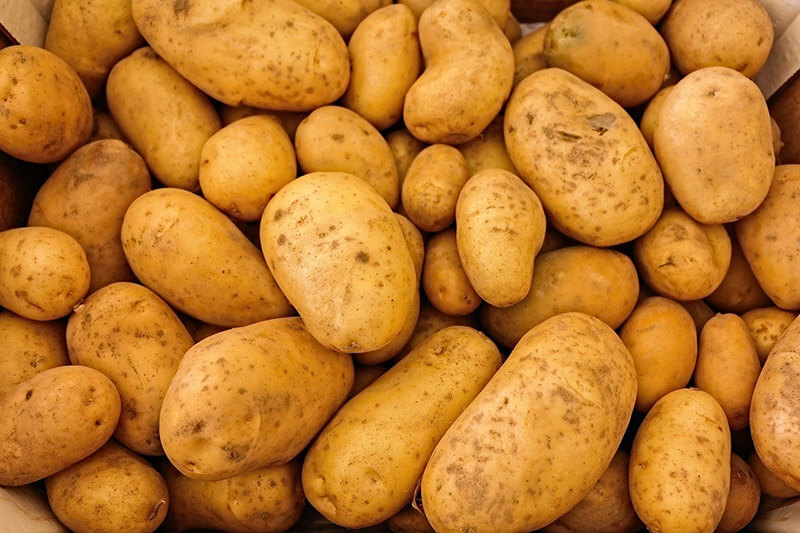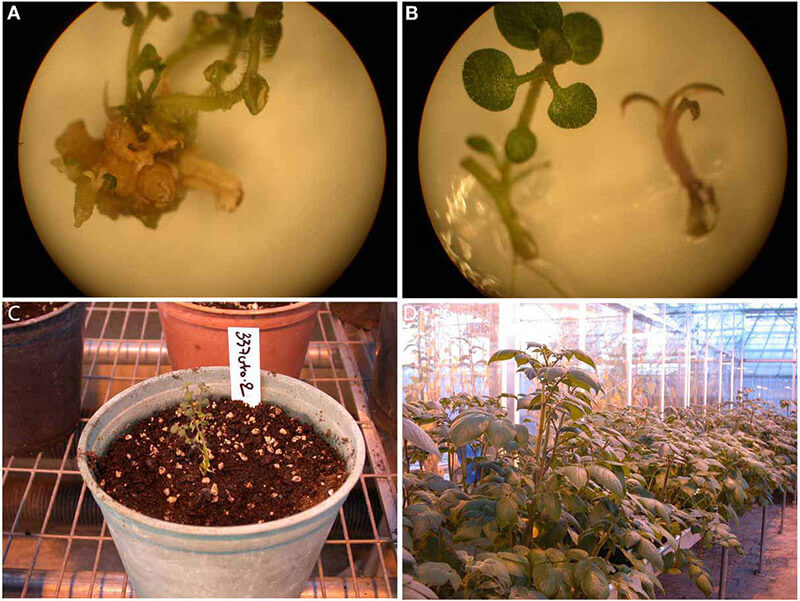Solanum tuberosum L., also known as potato, is the fourth most important crop of the world with annual production approaching 300 million tons, it is a root vegetable native to the Americas, a starchy tuber of the plant Solanum tuberosum, and the plant itself is a perennial in the nightshade family, Solanaceae. It is the fourth most important food crop in the world, second only to wheat, rice and corn. The tuber of potato contains a lot of starch, which can provide the human body with abundant energy, and is rich in protein, amino acids, vitamins and minerals, especially vitamins are the most complete of all food crops. In recent years, research on genetically modified Solanum tuberosum L. has become a hot field to improve Solanum tuberosum L. disease resistance, insect resistance, herbicide resistance, salt tolerance, cold tolerance, storage tolerance, yield, nutritional value, etc.

Lifeasible provides one-stop services, covering all steps including experimental design, vector construction, plasmid transformation, positive transplant screening and characterization of transgenic Solanum tuberosum L. We offer Solanum tuberosum L. transformation using various genetic engineering technologies as follows:
Through the quantitative overexpression of genes related to starch, lysine, tryptophan and other chemical components in Solanum tuberosum L., the production of specific compounds can be increased. We could help you overexpress many functional genes including genes related to herbicide resistance AHAS, GUS, genes affecting storage capacity like Ranger Russet's tuber-expressed polyphenol oxidase (Ppo), starch-associated R1, and phosphorylase-L (PhL) genes, and many other genes related to important traits of Solanum tuberosum L.
RNAi refers to the phenomenon of highly conserved, induced by double-stranded RNA (dsRNA), homologous mRNA high-efficiency and specific degradation in the evolutionary process. Through RNAi technology, the silencing of multiple genes in Solanum tuberosum L. can be mediated.
VIGS use viruses carrying target gene fragments to infect plants. After infect of the viruses, the endogenous genes of target plant can be silenced and phenotype of target plant may change, providing information for study of gene function. The VIGS technology is a method of transient transformation and can help you save time. With wealth of experience in VIGS, the scientists in Lifeasible provides you customized protocol for VIGS in Solanum tuberosum L. We could achieve the transformation for Solanum tuberosum L. with different genetic backgrounds.
The discovery of the CRISPR/Cas9 system provides us with a very powerful and convenient gene editing tool. By using CRISPR technology, we can achieve knockout of Solanum tuberosum L. genes in different ways, including frameshift mutations, multiple deletion of fragments, knockout of non-coding genes, knockout of multiple copies of genes, etc.
Using the powerful scalability of the CRISPR system, we have developed many methods that can improve gene knock-in efficiency and achieve precise editing of the Solanum tuberosum L. genome. Most of CRISPR gene knock-in is done through HDR. Therefore, we have developed different methods to increase the probability of HDR, thereby improving the efficiency of gene knock-in.
We could help you achieve the conversion from C to T or A to G in Solanum tuberosum L. using CBE and ABE, both of which rely on the DNA positioning capabilities of the CRISPR/Cas9 system. During single base editing, the C base deaminase or A base deaminase is located at a specific position in the genome, and it catalyzes the deamination reaction of C or A at a specific position and turns it into U or I. Then it is treated as T or G in the process of DNA replication, realizing the conversion from C to T or A to G.
The dCas system is an important branch of the CRISPR system. There are many ways to participate in the inhibition of gene expression. We provide a variety of solutions for the inhibition of Solanum tuberosum L. genes, including dCas9 binding to targeted DNA and realizing Inhibition of gene transcription through steric hindrance. In addition, gene knockdown can also be achieved by recruiting a fusion protein to the start site of gene transcription.
CRISPRa technology uses the powerful capabilities of Cas9 and sgRNA to fuse or recruit multiple proteins to enhance gene transcription. For Solanum tuberosum L. genes, we provide VPR technology, SAM technology and Suntag technology to allow the CRISPR system to carry more activation element and achieve a stronger activation effect after synergistic amplification.
The study of gene function has always been the core subject of biological research. The earliest genetic screening system established through forward genetics is very inefficient and has a huge workload. However, the reverse genetic screening system based on CRISPR technology can complete very low-cost mutation library construction work. The gene mutation library construction technology we provide for Solanum tuberosum L. including gene knockout library construction, gene knockdown library construction, and gene activation library construction. Moreover, single-cell sequencing is available for mutation screening.
DNA-free gene editing technology has received extensive attention from the industry in recent years. We provide DNA free Solanum tuberosum L. genome editing services, including transient expression of CRISPR/Cas9 plasmid DNA, in vitro transcription of CRISPR/Cas9, and pre-assembled ribonucleic acid composed of purified Cas9 protein and sgRNAs complex. These technologies can avoid the integration of foreign DNA and genome, and reduce off-target effects. In addition, compared with traditional techniques, these techniques can avoid the use of hybridization or backcrossing to isolate CRISPR/Cas9 chimeras, so they are cheaper and have shorter experimental cycles.
Genetic Transformation Process for Solanum tuberosum L.
So far, the most advanced and widely used method for the development of genetically modified Solanum tuberosum L. is Agrobacterium-mediated tuber transformation.
 Figure 1. Agrobacterium-mediatedSolanum tuberosum L. transformation by infecting tuber with Agrobacterium (A) Multiple shoot formation from 5 mm internodal explant of Desiree after 6 weeks in culture. (B) Selection of putative excised shoots on 50 mg/L kanamycin for 14 d, plantlet on left shows rooting and is a putative positive, plant on right has no rooting and can be rejected as a negative. (C) Newly transplanted shoot in a 12.5-cm pot of compost. (D) View of a transgenic population of Solanum tuberosum L. in a containment glasshouse, 6 week post-transplanting (Sun S, et al. 2015)
Figure 1. Agrobacterium-mediatedSolanum tuberosum L. transformation by infecting tuber with Agrobacterium (A) Multiple shoot formation from 5 mm internodal explant of Desiree after 6 weeks in culture. (B) Selection of putative excised shoots on 50 mg/L kanamycin for 14 d, plantlet on left shows rooting and is a putative positive, plant on right has no rooting and can be rejected as a negative. (C) Newly transplanted shoot in a 12.5-cm pot of compost. (D) View of a transgenic population of Solanum tuberosum L. in a containment glasshouse, 6 week post-transplanting (Sun S, et al. 2015)
Lifeasible offers our customers with professional one-stop services, covering all steps including experimental design, vector construction, plasmid transformation, positive transplant screening and testing. Adapting to diverse purposes of different customers, multiple Agrobacterium strains (EHA105, LBA4404, PC2760, etc.), as well as commercial and customized binary vectors with variant selectable markers (Kanamycin, Hygromycin, Phosphinothricin, G418, etc.) are readily available for your use. Experts at Lifeasible obtain comprehensive knowledge and years of experience to solve technical problems and challenges in Solanum tuberosum L. transformation. We can draw customized solution to help you research on a variety of genotype of Solanum tuberosum L.. Our services guarantee the success of your project. For more information or any inquiry requirements, please contact Lifeasible.
Reference
Lifeasible has established a one-stop service platform for plants. In addition to obtaining customized solutions for plant genetic engineering, customers can also conduct follow-up analysis and research on plants through our analysis platform. The analytical services we provide include but are not limited to the following:
STU-CRISPR System Improves Plant Genome Editing Efficiency
April 19, 2024
Application of Exosomes in Facial Beauty
April 12, 2024